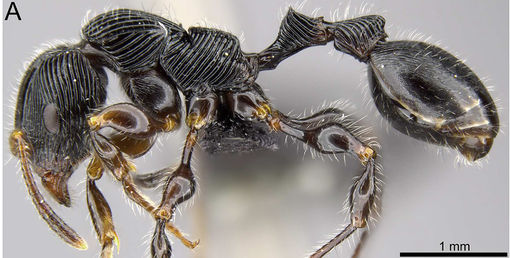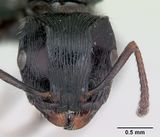Key to Terataner of Madagascar
This worker key is based on: Hita Garcia F, Fischer G, Liu C, Audisio TL, Alpert GD, Fisher BL, Economo E. (2017) X-Ray microtomography for ant taxonomy: An exploration and case study with two new Terataner (Hymenoptera, Formicidae, Myrmicinae) species from Madagascar. PLoS ONE 12(3).
Terataner are very conspicuous, heavily armoured, medium-sized to large arboreal or sub-arboreal ants that prey on ants, termites and other insects. Bolton provided the first modern taxonomic analysis of Terataner, in which he diagnosed the genus, re-described all Afrotropical species, described one new Malagasy species, gave species accounts for the remainder, and presented identification keys for all species. The latter study represents a solid foundation for the taxonomy of the genus, but no subsequent taxonomic studies have been published. Nevertheless, most modern ant inventories in the Afrotropics and, more importantly, in the Malagasy region were carried out after Bolton's revision. These studies generated 99% of the currently available material of Terataner, most of it originating from Madagascar, and to a lesser extent the neighbouring islands of the South West Indian Ocean. First examination of this material revealed that most of the species richness of Terataner is actually undescribed with upwards of 40 new Malagasy species. Based on these findings, the genus is in need of further taxonomic treatments.
The following key to species only diagnoses the valid species from the island of Madagascar and should be considered preliminary.
You may also be interested in
1
- Petiole with two very long spines and postpetiole with one very long median spine (Fig 3A) . . . . . Terataner alluaudi

|
- Petiole and postpetiole without very long spines (Fig 3B and 3C) . . . . . 2
2
return to couplet #1
- Dorsum of pronotum with conspicuously transverse sculpture (Fig 3D) . . . . . Terataner balrog
- Dorsum of pronotum with conspicuously longitudinally arranged sculpture (Fig 3E and 3F) . . . . . 3
3
return to couplet #2
- In full-face view head comparatively narrow (CI 87±91) with weakly convex sides, broadest at eye level and conspicuously narrowing towards posterior head margin before broadening again into well-developed angulate posterodorsal corners (Fig 3G). . . . . . Terataner nymeria
- In full-face view head never shaped as above (Fig 3H and 3I) . . . . . 4
4
return to couplet #3
- In profile postpetiole conspicuously rounded dorsally (Fig 3J and 3K); in dorsal view rounded, not shield-like nor with a transverse crest or ridge . . . . . 5
- In profile postpetiole cuneiform (Fig 3L and 3M); in dorsal view shield-like with a transverse crest or ridge . . . . . 6
5
return to couplet #4
- Metanotal groove strongly and deeply impressed; sculpture on lateral pronotum longitudinally rugose (Fig 3J) . . . . . Terataner foreli
- Metanotal groove distinct but only moderately impressed; sculpture on lateral pronotum diagonally costate (Fig 3K) . . . . . Terataner steinheili
6
return to couplet #4
- Surface sculpture on lateral pronotum longitudinally rugose; procoxae usually unsculptured, rarely with traces of sculpture; legs yellowish light brown (Fig 3L) . . . . . Terataner rufipes
- Surface sculpture on lateral pronotum transversely costate; procoxae conspicuously longitudinally rugulose/rugose; legs dark brown to black (Fig 3M) . . . . . Terataner xaltus
























